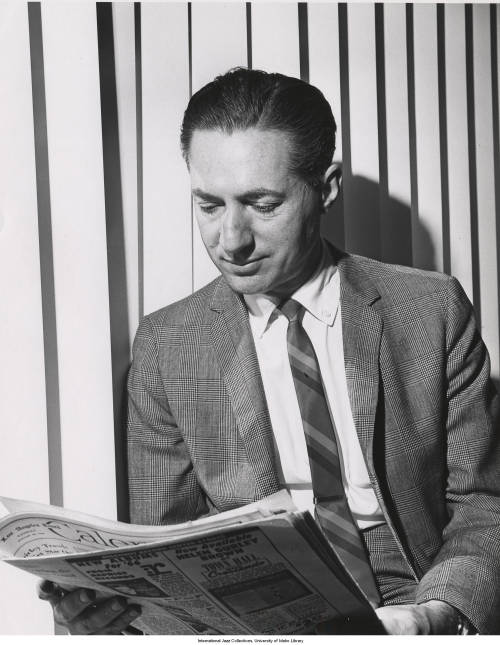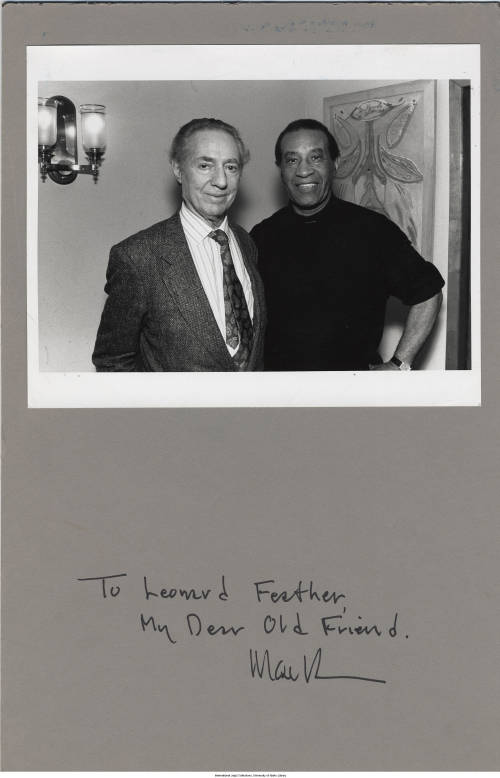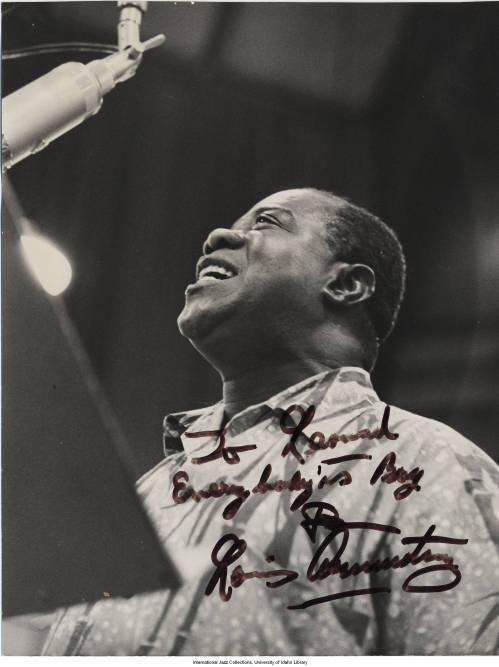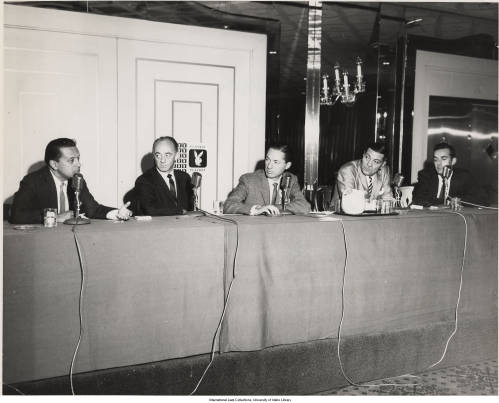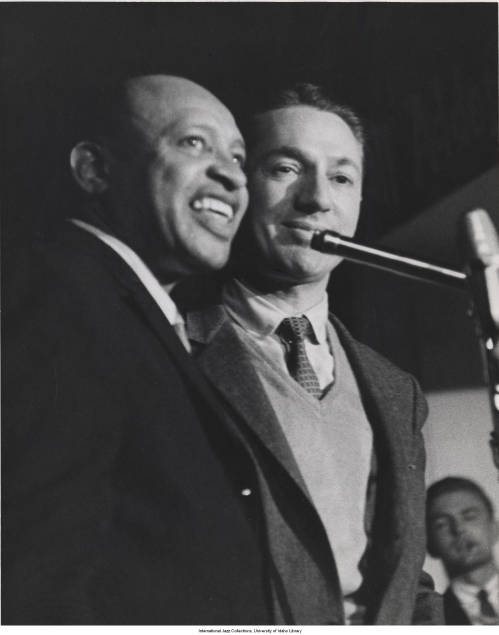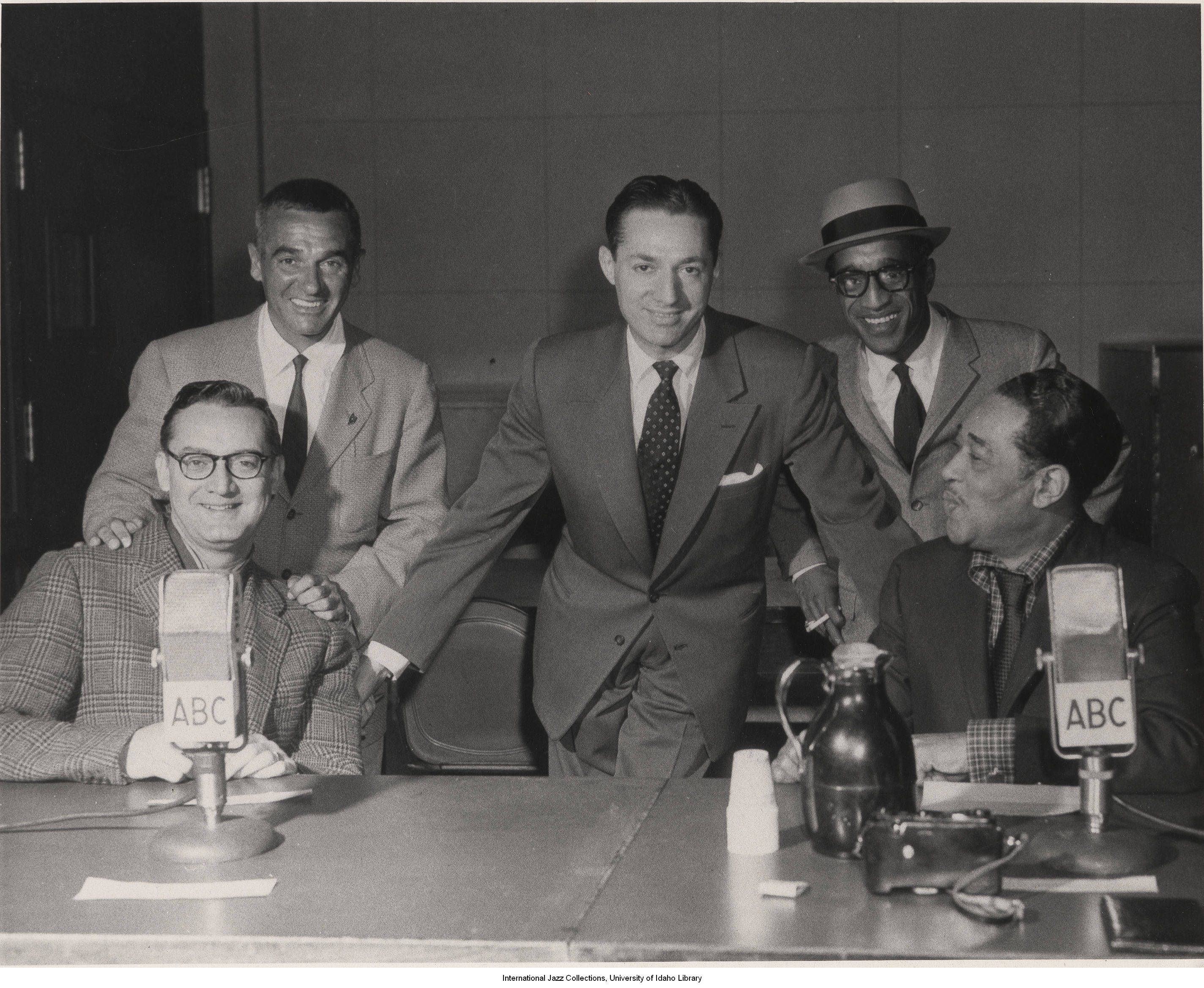Leonard Feather Blindfold Tests
Historic interviews with jazz musicians, recorded by jazz critic Leonard Feather
Contents: Leonard Feather | The Blindfold Tests | A Pivotal Moment in Jazz History | The Blindfold Tests at the University of Idaho | Contributors | Tech
Leonard Feather
Feather was born in London in 1914, and he fell in love with jazz after hearing a 1928 recording of “West End Blues” by Louis Armstrong and his Hot Five. While young, he learned jazz piano and began experimenting with jazz composition.
His journalistic career started shortly after high school and eventually led him to the United States, where his knack for making important connections with major figures in jazz was a crucial component in developing the networks of jazz musicians that allowed him to be successful not only as a journalist, but also as a composer, broadcaster, and publicist.
Beyond his work for American jazz magazines like Metronome and Downbeat, he published important books on jazz history that are still highly regarded today, including an Encyclopedia of Jazz (1960) and Inside Be-Bop (1949).
The Blindfold Tests
Feather first conceived of the Blindfold Tests as a reaction to the biased rankings that appeared in jazz magazines in the 19430s and 40s. In popular jazz magazines of the time, critics and readers regularly ranked what they determined to be the best records and musicians. Feather did not think all musicians were being fairly considered in these rankings: issues like race and gender heavily swayed people’s opinions. He did not trust the public’s opinion (or many of his fellow critics’ opinions, for that matter), nor did he trust that they were fully informed of all possible choices before making their selections.
Feather decided that the solution to this problem was that the music should be judged by experts. And in his opinion, the experts were not critics like himself or the public, but the very musicians who were creating the music.
And so the idea for the Blindfold Test was born, and its classic formula would remain consistent across multiple publication venues for almost fifty years. The design was simple: Feather would play several selections for a “blindfolded” jazz musician, who was not shown the record or given any information about the song that was played. The musician would listen to the piece, then give Feather their guess as to who was playing. Feather also wanted musicians to talk about the style of the selections, and to give them a quality score of one to five. In these discussions, musicians voiced their opinions about recordings, the jazz art form, and the practice of being a professional jazz musician.
A typical session lasted anywhere from 5-10 musical selections and was usually recorded by Feather. Afterwards, Feather would edit and transcribe the musicians’ responses into writing, then publish them in popular jazz journals.
Feather’s first blindfold test appeared in the September 1946 issue of Metronome magazine, where it became a regular monthly feature before migrating to three other journals and onto the radio airwaves throughout the rest of his career. Over the course of his career, Feather conducted several hundred tests, and it’s safe to say they included almost every famous jazz artist and were representative of almost all major jazz styles.
Just a few of the musicians who participated in the Blindfold Tests include Oscar Peterson, Count Basie, Carmen McRae, Quincy Jones, Dave Brubeck, John Coltrane, Dinah Washington, Dizzy Gillespe, Miles Davis, Charlie Parker, Aretha Franklin, Chick Corea, Maynard Ferguson, and Wynton Marsalis.
A Pivotal Moment in Jazz History
Feather was situated perfectly to capture and interrogate debates that were happening in a controversial and pivotal time in jazz history, during the 1950s and 60s. As a whole, the tests capture a number of opinions from almost all the most famous jazz musicians of this era.
Feather was lucky that, in the early 1950s, many early jazz musicians who helped establish and popularize jazz such as Louis Armstrong and Jack Teagarden were still flourishing and able to comment on younger artists who were playing newer and much different styles. This 20-year period was pivotal because hard bop, cool jazz, modal, free jazz, avant-garde, fusion, and other styles emerged and were being developed.
Through the tests, artists commented on nearly every issue in jazz, even those that were sometimes controversial in nature. These include, but are not limited to, music criticism, aesthetics, recording and audio equipment technology, different jazz styles, instrumental and vocal technique, geography, gender, race, and individual musicians’ definitions of jazz.
One example of Feather’s agenda in pursuing these issues can be seen in Paul Desmond’s test from 1958, where Feather discusses West Coast style jazz. Feather repeatedly presses Desmond to make a guess throughout the test: was this selection recorded on the West or East coast?
Leonard Feather and Paul Desmond, Blindfold Test Excerpt
| Feather: | Well, ah, one thing that might surprise you, or it might not, is that all the records I played were made on the west coast. |
| Desmond: | [sighs] Oh |
| Feather: | It doesn’t, I don’t think it proves anything either way, but it ah, it sort of might be of interest. I was just wondering what we can, uh? |
| Desmond: | That is interesting. |
| Feather: | Does it demonstrate anything? |
| Desmond: | Demonstrates that they have recording studios at both ends of the continent, and that people travel. |
| Feather: | Yeah, I guess that’s—, and you get all styles on both coasts, right? |
| Desmond: | Certainly, I never said anything to the contrary. |
| Feather: | No, but so many people have |
| Desmond: | Oh |
| Feather: | and coming from an authoritative voice, it might carry some weight. If you’d, but you haven’t said that. |
| Desmond: | I always thought it was the critics more than anyone else who fostered the East Coast-West Coast… |
| Feather: | I think so too. |
| Desmond: | dichotomy because they need things to write about. They’re professional pigeonholers. |
| Feather: | That’s right. |
(Read and listen to the full Paul Desmond Blindfold Test)
Of course, in pursuing these kinds of issues Feather couldn’t escape his own biases and his influence is keenly felt in the tracks he chooses and the questions he uses to prompt his subjects.
However, despite his inability to be completely objective, in the end Feather did accomplish something extraordinary: he was able to capture a conversation around a dynamic art form, not as observed by outsiders and critics, but from the people who were actively pushing the boundaries of contemporary jazz: the musicians themselves.
The Blindfold Tests at the University of Idaho
A small selection of Feather’s recorded Blindfold Tests is preserved in the University of Idaho’s Special Collections and Archives. These recordings range from 1953 to 1986, with most dating from around the late 1950s and early 1960s. Digitized straight from Feather’s reels, a total of 23 Blindfold Tests have been identified and have been made accessible through this digital collection.
We hope you enjoy sifting through this unique archive to learn more about the history of jazz and the conversations it inspires.
Contributors
- Mitchell Gibbs, Lionel Hampton School of Music Undergraduate Student and 2019 Berry International Jazz Fellow
- Liam Marchant, Lionel Hampton School of Music Undergraduate Student
Technical Credits - CollectionBuilder
This digital collection is built with CollectionBuilder, an open source tool for creating digital collection and exhibit websites that is developed by faculty librarians at the University of Idaho Library following the Lib-STATIC methodology.
This site is built using CollectionBuilder-CDM which utilizes CONTENTdm APIs to create an engaging “skin” on top of an existing digital collection repository.

